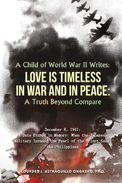
 |
Author Ongkeko summons recollections from December 8, 1941—a date that, for her and her Philippine family and nation, will, like the preceding date for Americans, “live in infamy.” Beginning early on the eighth, Japanese forces set out to capture the strategic American fortress of Camp John Hay in the Philippines and occupy the country. For thirteen-year-old Ongkeko, the horrors of that morning broke forth while she was attending high school, with sudden deafening explosions filling the air, pieces of the shattered materials falling to the ground, and heavy smoke pervading. As the explosions grew closer and chaos replaced any hope of safety, Ongkeko and a few friends banded together to get home, crying and screaming, unable to believe that this could be happening to their beloved Baguio, a gem of a city set in the high mountains of Luzon.
Once home, Ongkeko found her highly alert, very protective father already preparing to guard his family by building an air raid shelter over their property, which fortunately included a small spring that served as a water supply. He immediately told Ongkeko, an award-winning student, that she must enroll in the Japanese Language School so that their brood would understand the conqueror’s orders and intentions. This took on a deeper significance when the girl witnessed her father being brutally beaten by Japanese soldiers after failing to bow correctly according to their instructions. Ongkeko became a favored pupil of her Japanese instructor and an interpreter for family and friends, teaching simple Japanese phrases and even negotiating with soldiers on some critical neighborhood issues. Though the restrictions placed on her fellow citizens were gradually loosened, all Philippine citizens longed for the moment when US General Douglas MacArthur would be able to keep his promise to return and liberate their country.
With a personal history that recalls her family’s immigration to America after World War II, Ongkeko has assembled her vivid, sometimes shocking memories of those painful years not as a litany of sorrows, though there were many, but as a beacon of hope for her readers. Her narrative clearly exhibits that her admiration for her parents was well founded, as she and her siblings were urged to achieve academically and maintain religious faith despite the harsh conditions of enemy occupation that scarred their adolescence. The author also doesn’t gloss over her own painful moments and struggles, revealing these times with refreshing candor. For example, Ongkeko’s woes were exacerbated by a protracted time in the hospital with appendix problems during those stress-filled years, causing her to ask a Catholic priest for the blessing of extreme unction, so great was her wish not to depart “this terrestrial globe” even in the midst of the war’s horrors.
Additionally, she is quick to point out the contributions of others in her story. For instance, support from city folk, school officials, and a few Japanese individuals who admired her facility with language played a role in her saga of danger and diligence. But her greatest encouragement, she emphasizes, was the love within her family—the unflagging determination of her selfless father and mother to ensure that she and her siblings would progress despite the harrowing atmosphere, bound together in abiding devotion that has allowed her to fulfill their dreams and her own. Ongkeko’s poignant yet ultimately inspiring memoir is a credit to her persistent, positive perspective and can serve as motivation to anyone facing seemingly insurmountable challenges, demonstrating that even a global war cannot destroy love at its best.
RECOMMENDED by the US Review